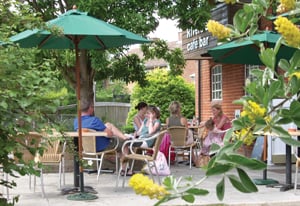Food for thought
Alison O’Neill shares some advice on making the most out of your venue’s catering arm

The Farnham Maltings has a café and two designated bars, which serve the walk-in public and customers for theatre, comedy, music, private functions, meetings, associate artists and our studio residents. Just over a year ago, our catering franchisee resigned after a three-year residency. Consideration was given to engaging another franchise, bringing the service in-house or combinations of both.
In our case, the lack of serious interest from franchise applicants discounted the first option and we advertised for a catering manager – taking the view that the decision was reversible. Today, we are still running an in-house service, have increased catering revenue by 40% and net contribution to the business by 20%. Despite obvious apprehension, our client base is established and our previous franchisees made respectable contributions. This was not a stop-start venture.
Immediately, we were required to take on the franchise staff in accordance with Transfer of Undertakings (Protection of Employment) Regulations. As with most legal issues, this has been the least intelligible and definable aspect, despite help from an external advisory service and Internet resources. In particular, there are implications relating to contractual terms. In our experience, before you issue any statements to the transferring personnel, you must evaluate the skillset requirement, especially if the franchise was owned or led by a hands-on sole trader or partnership. Economic, technical or organisational reasons for changes in the workforce are permitted and must be considered before you commit.
Aside from the legal requirements, you have to consider the cultural and behavioural aspects of taking on someone else’s staff. Our manager spent considerable time talking to the individuals about how the business had run to date, key events, their expectations, fears and desires. The participatory style brought easy wins such as the transition from a weekly to a monthly rota. Staff could plan their lives outside work and this has reduced absences. Naturally, it took some time for the staff to feel wholly integrated but the investment in professional training discouraged prolonged circumspection. The high staff turnover characteristic of the catering sector presents problems for meeting training standards in food hygiene and the selling of alcohol. Personal licences also needed to be arranged. Most arts organisations run their cafés as a service to their visitors, so breaking even can be tricky. However, it cannot be allowed to drain healthy margins earned elsewhere. We addressed this by identifying our position amongst local eateries and exploiting it with our menu offer and execution.
Risk was another challenge. Assessment of risk in terms of cash-handling, stock control and staff timesheet recording are vital. In my experience, you are designing the operational processes using a risk-minimising approach. Elimination of risk is unrealistic, as any inspector in the hospitality trade will tell you. We chose to introduce touch-screen tills with a back office stock system. Essentially, it gives us reasonable stock valuation figures but also qualitative information and a degree of control. The management information is there at any level we require. Stock counts are regular and random. Our diary is cyclical so that we can match the catering offer to the expected audience, although our manager has learnt to adopt a shorter ordering lead time rather than being tempted by supplier bulk-buy offers. Bars return the greatest margin, so a noticeable advantage has been the interest in marrying the stock to the audience profile. This also means the customer has a better experience of the venue, which is all-important for repeat business. Attracting discretionary leisure spend is crucial for the foreseeable future. Administration tasks include the provision of floats, reconciliation of cash and investigation of variances. This takes one person nearly 20 hours a week to process. At the start, we even inherited a weekly cash payroll. In addition, there are the practical issues of storing cash and transporting it to the bank.
For us, the benefits of bringing the service in-house far outweigh any negative experiences and the obvious extra workload. Venue hire is our greatest source of income, so the elimination of the third-party liaison for any hire has been a noticeable relief for all concerned. Every event serviced by catering is ‘ours’ and the customer now receives a more consistent product as the staff effort is for the same end. Our confidence in handling private functions is now tested and this is a lucrative market. The introduction of an all-inclusive party package has seen many more enquiries turn into actual bookings. Our café is now in profit with extended openings three days per week to accommodate the pre-show demand, and regularly hosts live acoustic sets.
Fundamentally, customer service is at the heart of our appraisal. Whether you are dealing with the box office or ordering a coffee, there is a new consistency and cohesion. Continuous organisational reassessment is the reality for survival in the arts sector going forward. This experience has generated new revenue opportunities and ambition across the board so, personally, I would be extremely reluctant to reverse the situation.
Join the Discussion
You must be logged in to post a comment.